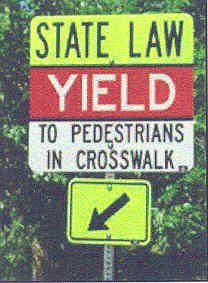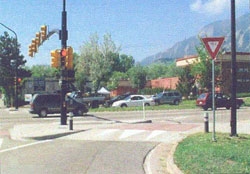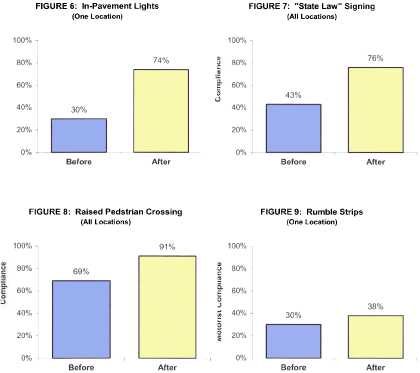City of Boulder Crosswalk Compliance Studies & Treatment Implementation
Boulder, Colorado
Source: Pedestrian and Bicycle Information Center (PBIC)
Problem
Poor driver compliance with crosswalk yield laws reduced pedestrian safety and in turn deterred people from walking.
Background
In 1996, the City of Boulder developed a comprehensive Pedestrian Crossing Treatment Warrants document to guide the installation of pedestrian improvements. A year later, the city hired a consultant to study compliance at crosswalks and test the effectiveness of alternative treatments.
Solution
The treatments selected for testing were designed to either bring attention to the crosswalk from the motorists' perspective or educate them of State Law. The treatments studied were: 1) rumble strips, 2) in-pavement lights, 3) sign-mounted lights, 4) "State Law" signing, and 5) raised pedestrian crossings.

"State Law" signage.
The study methodology involved noting the number of "yields" and "non-yields" for each instance where a pedestrian legally had the right-of-way. Data was collected on "typical" weekdays during AM, mid-day, and PM peak hours at each study location. "Before" studies were conducted at each location prior to the installation of alternative crosswalk treatments. The before condition most often included a marked crosswalk with standard MUTCD crosswalk signing. "After studies were performed six months after the treatments were installed. Studies were performed on a variety of roadway sizes, and pedestrian volumes in order to provide comparison.

A raised crosswalk at a right-turn bypass lane crossing.
Results
Before and after studies began in 1997 and continued through 2003. Treatments were implemented at a total of 39 crosswalk locations, and at 19 of these before and after conditions were evaluated.
Overall average motorist compliance increased from 34% to 77% for all locations with treatments installed. As would be expected, multi-lane roadways had lower compliance than single-lane roadways; however, they also experienced the highest percentage increase in motorist compliance, jumping from 21% to 63%. Pedestrian activated sign-mounted lights were found to have the largest impact among the treatments, raising compliance from 19% to 66%. This solution was less costly and more effective than in-pavement lights. "State Law" signing also proved effective, however the advance rumble strips were not nearly as effective as the other treatments. The raised pedestrian crossings were only installed at right-turn bypass islands (which had much higher compliance percentages to begin with), however they were found effective in increasing compliance from 69% to 91%. In accordance with these results, the City of Boulder continued using pedestrian-activated, sign-mounted flashing lights, "State Law" signing, and raised crossings at right-turn bypass islands. The rumble strips and in-pavement lights were discontinued. The Pedestrian Crossing Treatment Warrants was also updated to include the effective devices as treatment options for qualifying pedestrian crossings.

Contact
Steve Tuttle, P.E.
Senior Professional Engineer
Short Elliott Hendrickson Inc.
1375 Walnut Street, Suite 211
Boulder, CO 80302-5263
(303) 442-3130




